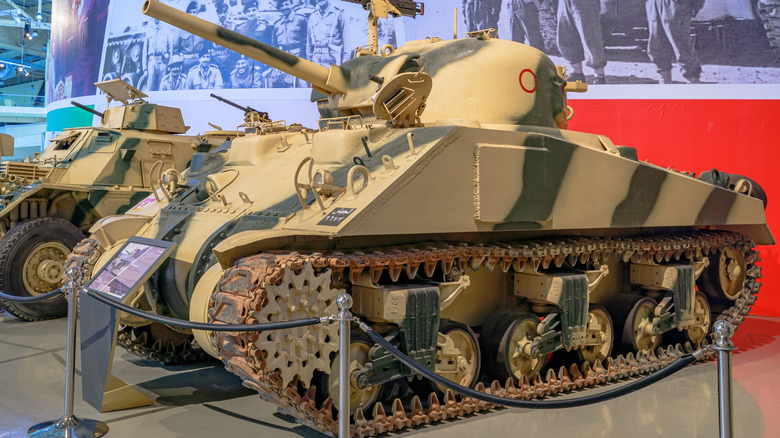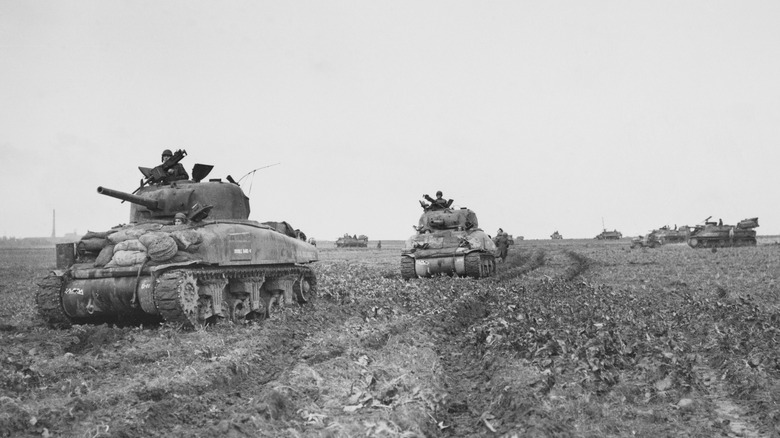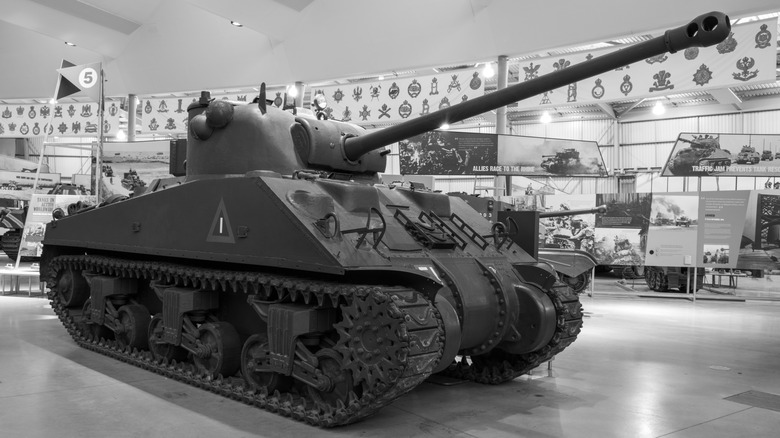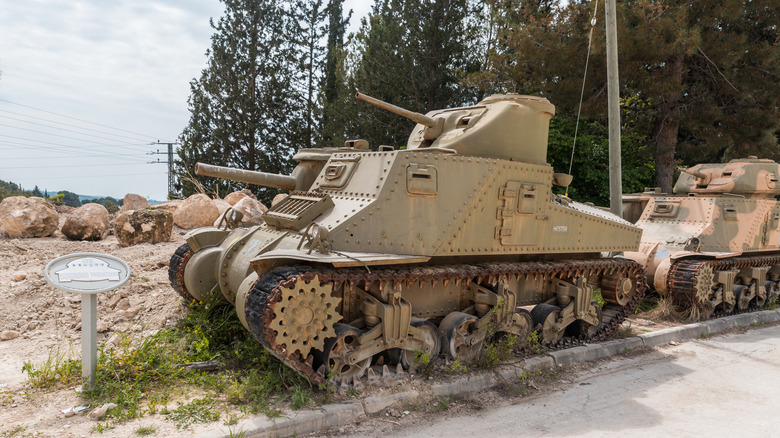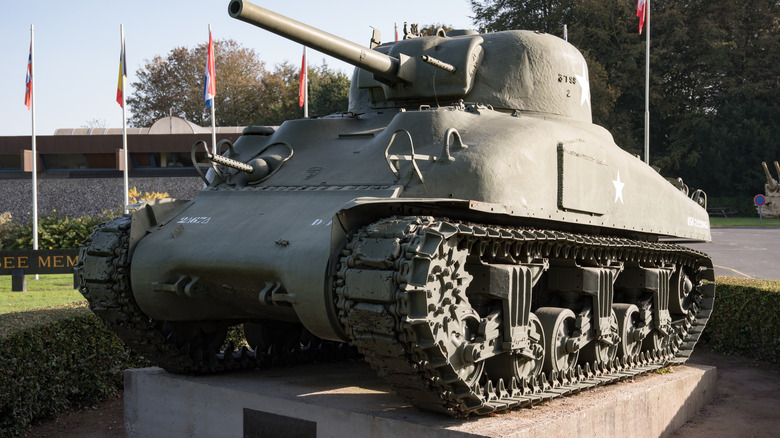Who Made The Sherman Tanks And Where Were They Made?
Sherman tanks would be an important part of the Allies' arsenal during World War II, a conflict that would be shaped by the use of tank tactics. The very first Shermans began to be manufactured for use in the conflict early in 1942, with design work and the creation of prototype models having been completed the previous year. One of the earliest models was the M4A1. Manufacturing such a mighty machine was a job for a plant with experience in developing just that, and the choice was simple. Lima Locomotive Works, in the Ohio city of Lima, built the first M4A1s.
Lima Locomotive Works began producing locomotives in 1879, and would continue to do so until the decade after World War II's conclusion, in 1956. By this time, it had become known as Baldwin-Lima-Hamilton after a merger, but it was as LLW that it began creating the Sherman. The U.S.-built model would first be wielded by British troops, distinguishing themselves at the Second Battle of El Alamein in the hands of the 8th Army.
The battle, which lasted almost two weeks from October 23 1942, may have ended very differently if not for 300 Sherman tanks that were sent from Lima for the Allies' use. The M4A1 weighed slightly over 30 tonnes, and its R975 gas engine could propel it at around 30mph. It was quite the formidable weapon, but it still had more evolving to do and more of a part to play in the developing war.
The production of the very first Sherman tanks
Extraordinary numbers of Sherman tanks were created over the course of World War II. 6,281 M4A1s were built alone, and development of the broader family in the quantities needed would require more bases than that of Lima Locomotive Works alone. To this end, U.S. industry heavyweight General Motors saw the need for a manufacturing plant that was dedicated to building tanks. In 1942, Michigan's Grand Blanc was selected as the site of a huge new plant for just that purpose. It would be known as the Fisher Body Grand Blanc Division, a site that would develop vast quantities of these vital war machines. It would be responsible for the development of 11,385 Sherman tanks (as well as many Pattons after the conflict).
The primary asset of the Sherman family was precisely that: Great numbers of them could be brought to bear because they were relatively easy to produce in such numbers. While quantity over quality is a gross oversimplification of military strategy, it certainly does hold true to an extent when considering the formidable power of the German tanks the Allies were facing. Tiger tanks may have packed a nasty bite that Shermans couldn't really stand up to one-on-one, but repairs were easier to perform and they were faster to produce, helping ensure the allies an advantage in numbers deployed. A defeated opposing tank, as such, could be considered more of a loss and harder to replace.
The Chrysler factory that developed Sherman tanks
Allies would also adapt the Sherman to their own specifications. One case in point is the Sherman Firefly (pictured here), a model developed by the British that proved to be one of the Allies' best tanks in World War II. The Firefly appeared in 1943 and featured a much-needed upgrade to the main gun. It was equipped with the British 17-pound cannon, a more powerful alternative than the 75mm gun the Sherman was originally fitted with.
The Sherman Firefly on display at The Tank Museum was originally created at the Chrysler Factory in Detroit, Michigan, with a British Royal Ordinance Factory adapting the Sherman to the Firefly variant. Chrysler was another acclaimed auto manufacturer that built Shermans.The marque, then led by K.T. Keller, took on the development of war machines in a government contract that was agreed upon in 1940. The next step was to find a premises that would be up to the considerable task of doing so.
The factory built for the purpose would be called the Detroit Arsenal. Between April 1941 and the end of the conflict, the Arsenal had manufactured no less than 22,234 tanks (though it didn't solely produce Shermans). Chrysler would also retroactively improve the armor of some Shermans in 1943, with the factory fitting new applique armor features to the body of the iconic tank. This upgrade was performed by Chrysler on the M4A4 Sherman, back at its premises on recall.
Other auto makers helped build tanks
The Sherman family proved to be a heavy focus of the Detroit Arsenal's output. The development of the Sherman was a difficult task for the Arsenal team to handle, especially in such great numbers, but wartime ingenuity and grit carried them through. Nowhere was this more evident than in the case of the M4's engine ... or rather, its five engines, because it was powered by a quintet of Chrysler car engines welded into one 30-cylinder behemoth.
This arrangement, historian David Fletcher stated in a Tank Chats episode on the M4A4 British Firefly, "sounds dreadful, but it work[ed] very well. Apparently, the engine was so reliable that the British rather liked the M4A4." Sherman construction would hit such a pace that the record was 907 built in a single month: December 1942.
Ford Motor Company is yet another auto manufacturing heavyweight that produced tanks. The Blue Oval created the M4A3 variant of the Sherman (an M3 is pictured here), and it was exclusively developed by the brand when its manufacture began. This tank sported a GAA V8 developed by Ford itself, a weight of just over 30 tons, and an arsenal that included .30 and .50 caliber machine guns in support of a hefty 75 mm gun. A select few M4A3s were armed with something rather more outlandish: a limited number were adapted by the navy to boast a flamethrower in place of that 75mm armament. A reported eight models received this treatment.
Canada's Grizzly Sherman and Israel's Super Sherman
The Sherman family has also been built, or assembled or adapted, in other nations too. One fascinating example is the case of the Sherman Grizzly. This variant was built elsewhere in North America, at the Montreal Locomotive Works in Canada. This version of the M4A1 has a unique origin, David Willey of The Tank Museum explains: "they decide, in Canada, "let's transfer production from the Ram tank over into making this new version of a Sherman that's going to be called the Grizzly." Approximately 188 Grizzlies are built until they became redundant with the pace of U.S. manufacture.
The world would see weirder variants of the Sherman tank too. Israel, on becoming an official state in May 1948, lacked the capacity to develop its own formidable war machines and equipment. The answer to this was to use its technicians' great resourcefulness to transform anything they could get their hands on into something workable. This led to the M-50 Sherman, which was Israel's blend of a dependable Sherman body and the mighty gun of a French AMX-13 light tank.
Shermans previously acquired from the armed forces of the Philippines and elsewhere were far from the cutting edge at this time, but France and Israel both had a vital part to play in building the new Sherman, known by some as the Super Sherman. Though only small numbers of the M-50 were made, this demonstrates the enduring international value of the Sherman family.
